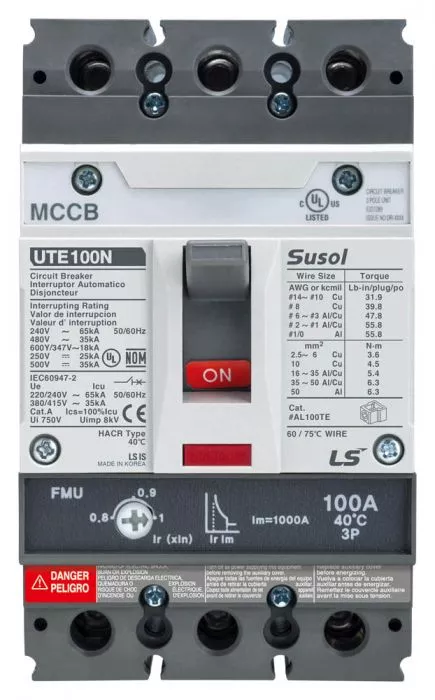1. Comparison of Non-Trip Circuit Breakers vs. Standard Circuit Breakers
1.1 Key Differences in Design and Function
| Feature | Non-Trip Circuit Breaker | Standard Circuit Breaker |
|---|---|---|
| Automatic Tripping | No (manual intervention required to disconnect) | Yes (trips automatically during faults) |
| Overcurrent Protection | Not provided by the breaker itself | Provided to protect wiring and devices |
| Manual Control | Required to disconnect the circuit | Optional (can trip automatically) |
| Primary Use | Maintenance, diagnostics, critical systems | General protection of circuits from overloads and faults |
Non-trip circuit breakers are designed to remain manually controlled, meaning they do not interrupt power automatically during an overcurrent or fault condition. This makes them suitable for applications where continuous power is essential, even if a fault occurs. Standard circuit breakers, on the other hand, are designed to automatically trip and disconnect power to protect equipment and wiring.
2. Detailed Application Examples
2.1 Emergency Systems (Fire Alarms, Life-Support Equipment)
In critical systems like emergency lighting, fire alarms, and life-support equipment, non-trip circuit breakers ensure that power remains available, even during fault conditions. This is crucial for life-safety applications where any loss of power could result in dangerous situations.
Example: Hospital Emergency Systems
- Scenario: In a hospital, power to critical devices such as ventilators and monitors must remain uninterrupted.
- Solution: Non-trip circuit breakers are used in the emergency power supply circuits. In the event of a fault, the breaker will not trip automatically, ensuring continuous power until the issue can be manually resolved.
Key Benefits:
- Continuous power to life-critical systems.
- Manual intervention allows troubleshooting without interrupting power.
2.2 Maintenance and Testing Circuits
Non-trip circuit breakers are commonly used in maintenance panels and test benches, where circuits need to remain energized for diagnostics and troubleshooting.
Example: Industrial Plant Maintenance
- Scenario: In an industrial facility, an engineer needs to diagnose a faulty motor control circuit.
- Solution: A non-trip circuit breaker ensures the circuit remains powered during diagnostics, allowing the engineer to identify the issue without losing power to the system.
Key Benefits:
- Improved diagnostics during maintenance.
- Prevents nuisance tripping during troubleshooting.
2.3 Data Centers and Telecommunications
In data centers and telecom facilities, uninterrupted power is critical to maintaining uptime. Non-trip circuit breakers are used to provide manual control over power distribution, ensuring that power remains available even during faults.
Example: Server Rack Power Control
- Scenario: A data center needs to maintain power to all server racks, even if a fault occurs in one rack.
- Solution: Non-trip breakers are used to isolate and troubleshoot the faulted rack without interrupting power to the entire system.
Key Benefits:
- Prevents downtime in critical infrastructure.
- Selective fault isolation to reduce system-wide outages.
3. Safety Considerations and Risks
While non-trip circuit breakers offer several benefits, they also present safety risks if used improperly. Below are some important safety considerations:
3.1 When to Use Non-Trip Circuit Breakers
- Emergency systems: For critical infrastructure where power continuity is essential.
- Maintenance/testing panels: When troubleshooting and diagnostics require uninterrupted power.
- Control circuits: For auxiliary systems in switchgear and motor control centers.
3.2 When NOT to Use Non-Trip Circuit Breakers
- General residential or commercial circuits: Non-trip breakers should not be used in places where automatic tripping is essential to prevent overheating, fires, or electrical hazards.
- High-risk fault scenarios: In circuits with high fault currents, automatic protection is crucial to prevent damage and ensure safety.
3.3 Risks of Non-Trip Circuit Breakers
| Risk | Description |
| Overheating | Without automatic tripping, circuits can overheat if faults are not addressed promptly. |
| Electrical Fires | Prolonged fault conditions can cause arcing and fire hazards. |
| Manual Error | Relying on manual intervention increases the risk of human error. |
4. Summary of Key Standards for Non-Trip Circuit Breakers
| Standard | Region | Description |
| IEC 60947-2 | International | Standard for low-voltage circuit breakers, including non-trip types. |
| UL 489 | U.S. | Standard for molded-case circuit breakers, including manual non-trip devices. |
| CSA C22.2 No. 5 | Canada | Canadian standard for circuit breakers, aligned with UL 489. |
| NFPA 70 (NEC) | U.S. | National Electrical Code providing guidelines for installation. |
5. Conclusion
Non-trip circuit breakers are essential components in specialized applications where continuous power is critical. While they provide benefits in terms of maintenance, diagnostics, and critical system protection, their use must be carefully managed to avoid safety risks. Understanding the standards, applications, and safety considerations is key to using them effectively.
